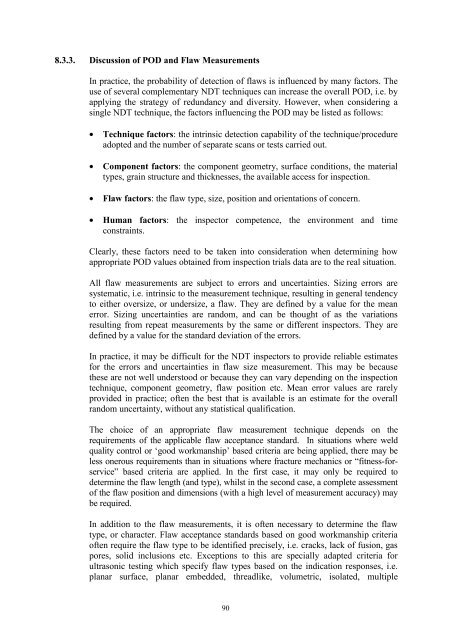Best Practice for Risk Based Inspection
risk based inspection
risk based inspection
You also want an ePaper? Increase the reach of your titles
YUMPU automatically turns print PDFs into web optimized ePapers that Google loves.
AE can be a very sensitive test method and has unique advantages in that:<br />
• It generally surveys the whole structure under test.<br />
• It does not require full access.<br />
• Only registers the presence of ‘active’ defects.<br />
However, it also has the disadvantage that it is very difficult to justify in<br />
comparison with conventional NDT techniques applied with full access. It is vital<br />
that there is confidence in the use of AE (resulting from experience of similar<br />
applications), particularly as the test is dynamic and cannot easily be verified by<br />
repetition. In general, it is not recommended that AE is used as the sole method of<br />
inspection unless there is rigour in justification.<br />
8.2.7. Magnetic Flux Leakage<br />
Magnetic flux leakage (MFL) is only applicable to ferromagnetic materials. The<br />
component is magnetised, and, depending on the level of induced flux density,<br />
magnetic flux leakage due to both near and far surface flaws is detected by the<br />
voltage induced in a detector coil, or Hall-effect sensor, traversed over the surface<br />
of the component. Unlike MPI, the method is not limited to surface breaking or<br />
near-surface flaws, but actually becomes increasingly sensitive to far surface flaws<br />
with increasing levels of magnetisation. The output from the detector can be<br />
amplified, filtered, digitised, stored etc. to produce an automated inspection system.<br />
Multiple-element and differential probes are also used, and inspection speeds can be<br />
very high.<br />
MFL is finding increasing use in the petrochemical industry <strong>for</strong> providing highspeed<br />
inspections of storage tank floors and carbon steel piping. These systems use<br />
either permanent or electromagnets to provide localised near-magnetic saturation<br />
coupled with induction coil or Hall-effect sensor arrays <strong>for</strong> detecting anomalous<br />
flux leakage caused by corrosion defects (both near as well as far surface). Many of<br />
these systems rely upon the use of an adjustable threshold, or amplitude gate, <strong>for</strong><br />
detection of corrosion in real-time. Some more advanced systems, through the use<br />
of computerised equipment with signal processing, provide corrosion maps of<br />
inspected areas similar to the C-scan presentation of ultrasonic data.<br />
8.3. ASSESSMENT OF INSPECTION PERFORMANCE AND RELIABILITY<br />
The normal process of inspection aims:<br />
• To detect and locate areas of deterioration or flaws of concern.<br />
• To determine their extent by providing flaw dimensions.<br />
• To determine the type, or character, of flaws.<br />
<strong>Inspection</strong> per<strong>for</strong>mance may be defined as the ultimate capabilities of an NDT<br />
technique to detect, size and determine the type of a flaw in a given component.<br />
<strong>Inspection</strong> reliability is a statistical measure of the expected variability in inspection<br />
per<strong>for</strong>mance in many applications of the technique.<br />
86



